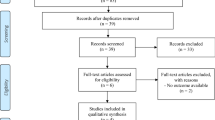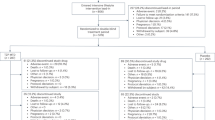Abstract
BACKGROUND: Treatment of obese subjects with topiramate has recently been associated with significant weight loss in a 6-month dose-ranging study.
OBJECTIVE: To investigate the long-term efficacy and safety of topiramate in obese subjects.
DESIGN: Randomised, double-blind, placebo-controlled study investigating three doses of topiramate: 96, 192, and 256 mg/day. All subjects also participated in a nonpharmacological weight-loss programme.
SUBJECTS: The study included 1289 subjects 18–75 y with a body mass index ≥30 kg/m2 and <50 kg/m2 in the absence of comorbidities, or ≥27 kg/m2 and <50 kg/m2 in the presence of controlled hypertension and/or dyslipidaemia.
DURATION: The original study design was for a 6-week, single-blind, placebo run-in phase followed by an 8-week titration phase and 2 y of maintenance at the assigned dose. Sponsor ended study early in order to develop a new controlled-release formulation with the potential to enhance tolerability and simplify dosing in this patient population. Therefore, none of the subjects completed the full 2 y of treatment. Efficacy results are based on subjects who were enrolled early enough to have had an opportunity to complete 1 y at their assigned dose (modified intent-to-treat population, MITT) before learning of the decision to terminate the study. Safety results are based on all subjects who took at least one dose of study medication.
RESULTS: The safety population consisted of 1282 subjects, and the MITT efficacy population was 854 subjects. At 60 weeks, subjects in the placebo group lost 1.7% of their baseline body weight, while subjects in the topiramate 96, 192, and 256 mg/day treatment groups lost 7.0, 9.1, and 9.7%, respectively (P<0.001, MITT, last observation carried forward). Weight loss ≥5% of baseline weight was achieved by 18% of subjects in the placebo arm vs 54, 61, and 67% of subjects receiving topiramate 96, 192, and 256 mg/day, respectively; weight loss ≥10% was achieved by 6 vs 29, 40, and 44%, respectively (P<0.001). Weight loss was accompanied by significant improvements in blood pressure (systolic/diastolic changes of +0.4/+1.0, −3.1/−1.3, −5.7/−3.4, and −4.6/−2.4 mmHg were observed for placebo, topiramate 96 mg/day, 192 mg/day, and 256 mg/day, respectively, P<0.001) and glucose and insulin. The most common adverse events more frequently observed in topiramate-treated subjects occurred mostly during the titration phase and were related to the central or peripheral nervous system and included paresthesia, difficulty with concentration/attention, depression, difficulty with memory, language problems, nervousness, and psychomotor slowing.
CONCLUSION: Topiramate treatment of obese subjects over the course of 1 y resulted in clinically significant weight loss. Improvements were also observed in blood pressure and glucose tolerance.
This is a preview of subscription content, access via your institution
Access options
Subscribe to this journal
Receive 12 print issues and online access
$259.00 per year
only $21.58 per issue
Buy this article
- Purchase on Springer Link
- Instant access to full article PDF
Prices may be subject to local taxes which are calculated during checkout




Similar content being viewed by others
References
James PT, Leach R, Kalamara E, Shayeghi M . The worldwide obesity epidemic. Obes Res 2001; 9 (Suppl 4): S228–S233.
Seidell JC . Obesity, insulin resistance and diabetes—a worldwide epidemic. Br J Nutr 2000; 83 (Suppl 1): S5–S8.
Mokdad AH, Bowman BA, Ford ES, Vinicor F, Marks JS, Koplan JP . The continuing epidemics of diabetes and obesity in the United States. JAMA 2001; 286: 1195–1200.
Flegal KM, Carroll MD, Ogden CL, Johnson CL . Prevalence and trends in obesity among US adults, 1999–2000. JAMA 2002; 288: 1723–1727.
National Task Force on the Prevention and Treatment of Obesity. Overweight, obesity, and health risk. Arch Intern Med 2000; 160: 898–904.
Garrison RJ, Castelli WP . Weight and thirty-year mortality of men in the Framingham Study. Ann Intern Med 1985; 103: 1006–1009.
Allison DB, Fontaine KR, Manson JE, Stevens J, VanItallie TB . Annual deaths attributable to obesity in the United States. JAMA 1999; 282: 1530–1538.
Resnick HE, Valsania P, Halter JB, Lin X . Relation of weight gain and weight loss on subsequent diabetes risk in overweight adults. J Epidemiol Community Health 2000; 54: 596–602.
Brown CD, Higgins M, Donato KA, Rohde FC, Garrison R, Obarzanek E, Ernst ND, Horan M . Body mass index and the prevalence of hypertension and dyslipidemia. Obes Res 2000; 8: 605–619.
Kaufman JS, Durazo-Arvizu RA, Rotimi CN, McGee DL, Cooper RS, for the Investigators of the International Collaborative Study on Hypertension in Blacks. Obesity and hypertension prevalence in populations of African origin. Epidemiology 1996; 7: 398–405.
Rimm EB, Stampfer MJ, Giovannucci E, Ascherio A, Spiegelman D, Colditz GA, Willett WC . Body size and fat distribution as predictors of coronary heart disease among middle-aged and older US men. Am J Epidemiol 1995; 141: 1117–1127.
Rexrode KM, Hennekens CH, Willett WC, Colditz GA, Stampfer MJ, Rich-Edwards JW, Speizer FE, Manson JE . A prospective study of body mass index, weight change, and risk of stroke in women. JAMA 1997; 277: 1539–1545.
Hochberg MC, Lethbridge-Cejku M, Scott Jr WW, Reichle R, Plato CC, Tobin JD . The association of body weight, body fatness and body fat distribution with osteoarthritis of the knee: data from the Baltimore Longitudinal Study of Aging. J Rheumatol 1995; 22: 488–493.
Tuomilehto J, Lindström J, Eriksson JG, Valle TT, Hämäläinen H, Ilanne-Parikka P, Keinänen-Kiukaanniemi S, Laakso M, Louheranta A, Rastas M, Salminen V, Uusitupa M, for the Finnish Diabetes Prevention Study Group. Prevention of type 2 diabetes mellitus by changes in lifestyle among subjects with impaired glucose tolerance. N Engl J Med 2001; 344: 1343–1350.
Diabetes Prevention Program Research Group. Reduction in the incidence of type 2 diabetes with lifestyle intervention or metformin. N Engl J Med 2002; 346: 393–403.
Cutler JA . Randomized clinical trials of weight reduction in nonhypertensive persons. Ann Epidemiol 1991; 1: 363–370.
Ard JD, Rosati R, Oddone EZ . Culturally-sensitive weight loss program produces significant reduction in weight, blood pressure, and cholesterol in eight weeks. J Natl Med Assoc 2000; 92: 515–523.
Topiramate (Topamax®) tablets. Physicians' Desk Reference. Medical Economics Co., Inc: Montvale, NJ; 2002. pp 2590–2595.
Richard D, Ferland J, Lalonde J, Samson P, Deshaies Y . Influence of topiramate in the regulation of energy balance. Nutrition 2000; 16: 961–966.
Bray GA, Hollander P, Klein S, Kushner R, Levy B, Fitchet M, Perry BH, for the US Topiramate Research Group. A 6-month randomized, placebo-controlled dose-ranging trial of topiramate for weight loss in obesity. Obes Res 2003; 11: 722–733.
Energy and protein requirements: report of a Joint FAO/WHO/UNU Expert Consultation. Technical report series no. 724. World Health Organization: Geneva; 1985. p 71.
Dunnett CW, Tamhane AC . Step-down multiple tests for comparing treatments with a control in unbalanced one-way layouts. Stat Med 1991; 10: 939–947.
Wirth A, Krause J . Long-term weight loss with sibutramine: a randomized controlled trial. JAMA 2001; 286: 1331–1339.
Smith IG, Goulder MA, on behalf of the Members of the Sibutramine Clinical Study 1047 Team. Randomized placebo-controlled trial of long-term treatment with sibutramine in mild to moderate obesity. J Fam Pract 2001; 50: 505–512.
Davidson MH, Hauptman J, DiGirolamo M, Foreyt JP, Halsted CH, Heber D, Heimburger DC, Lucas CP, Robbins DC, Chung J, Heymsfield SB . Weight control and risk factor reduction in obese subjects treated for 2 years with orlistat: a randomized controlled trial. JAMA 1999; 281: 235–242.
Torgerson JS, Hauptman J, Boldrin MN, Sjostrom L . XENical in the prevention of diabetes in obese subjects (XENDOS) study: a randomized study of orlistat as an adjunct to lifestyle changes for the prevention of type 2 diabetes in obese patients. Diabetes Care 2004; 27: 155–161.
Sjostrom L, Rissanen A, Andersen T, Boldrin M, Golay A, Koppeschaar HP, Krempf M . Randomised placebo-controlled trial of orlistat for weight loss and prevention of weight regain in obese patients. European Multicentre Orlistat Study Group. Lancet 1998; 352: 167–172.
James WP, Astrup A, Finer N, Hilsted J, Kopelman P, Rossner S, Saris WH, Van Gaal LF . Effect of sibutramine on weight maintenance after weight loss: a randomised trial. STORM Study Group. Sibutramine Trial of Obesity Reduction and Maintenance. Lancet 2000; 356: 2119–2125.
Bray GA, Blackburn GL, Ferguson JM, Greenway FL, Jain AK, Mendel CM, Mendels J, Ryan DH, Schwartz SL, Scheinbaum ML, Seaton TB . Sibutramine produces dose-related weight loss. Obes Res 1999; 7: 189–198.
Carpenter KM, Hasin DS, Allison DB, Faith MS . Relationships between obesity and DSM-IV major depressive disorder, suicide ideation, and suicide attempts: results from a general population study. Am J Public Health 2000; 90: 251–257.
Picard F, Deshaies Y, Lalonde J, Samson P, Richard D . Topiramate reduces energy and fat gains in lean (Fa/?) and obese (fa/fa) Zucker rats. Obes Res 2000; 8: 656–663.
York DA, Singer L, Thomas S, Bray GA . Effect of topiramate on body weight and body composition of Osborne–Mendel rats fed a high-fat diet: alterations in hormones, neuropeptide, and uncoupling-protein mRNAs. Nutrition 2000; 16: 967–975.
Richard D, Picard F, Lemieux C, Lalonde J, Samson P, Deshaies Y . The effects of topiramate and sex hormones on energy balance of male and female rats. Int J Obes Relat Metab Disord 2002; 26: 344–353.
White HS, Brown SD, Woodhead JH, Skeen GA, Wolf HH . Topiramate enhances GABA-mediated chloride flux and GABA-evoked chloride currents in murine brain neurons and increases seizure threshold. Epilepsy Res 1997; 28: 167–179.
Gibbs III JW, Sombati S, DeLorenzo RJ, Coulter DA . Cellular actions of topiramate: blockade of kainate-evoked inward currents in cultured hippocampal neurons. Epilepsia 2000; 41 (Suppl 1): S10–S16.
Taverna S, Sancini G, Mantegazza M, Franceschetti S, Avanzini G . Inhibition of transient and persistent Na+ current fractions by the new anticonvulsant topiramate. J Pharmacol Exp Ther 1999; 288: 960–968.
Dodgson SJ, Shank RP, Maryanoff BE . Topiramate as an inhibitor of carbonic anhydrase isoenzymes. Epilepsia 2000; 41 (Suppl 1): S35–S39.
Acknowledgements
This trial was supported by Johnson & Johnson Pharmaceutical Research and Development, LLC. The members of the OBES-002 Study Group are: Dammann, Hanns-Gerd, Hamburg, Germany; Ditschuneit, Herwig H, Ulm, Germany; Eichler, Hans Georg, Vienna, Austria; Elte, Jan Willem, Rotterdam, The Netherlands; Finer, Nicholas, Luton, UK; Foerster, Hanns-Michael, Duisburg Baerl, Germany; Hamann, Andreas, Heidelberg, Germany; Hanefeld, Markolf, Dresden, Germany; Häring, Hans-Ulrich, Tübingen, Germany; Hoppichler, Friedrich, Salzburg, Austria; Klör, Hans-Ulrich, Giessen, Germany; Kopelman, Peter, London, UK; Laederach-Hofmann, Kurt, Bern, Switzerland; Lean, Michael, Glasgow, UK; Mathus-Vliegen, Elisabeth, Amsterdam, The Netherlands; Moore, Ray, Kwa-Zulu Natal, South Africa; Mustajoki, Pertti, Helsinki, Finland; Niskanen, Leo, Kuopio, Finland; Prager, Rudolf, Vienna, Austria; Rissanen, Aila, Helsinki, Finland; Rössner, Stephan, Huddinge, Sweden; Scheen, André, Sart Tilman, Liège, Belgium; Scheen, André, Quai Godefroid Kurth, Liège, Belgium; Sharma, Ayra Mitra, Berlin, Germany; Sjöström, Lars, Göteborg, Sweden; Usadel, Klaus-Henning, Frankfurt, Germany; Van der Merwe, Maria Teresa, Johannesburg, South Africa; Van Gaal, Luc, Edegem, Belgium; Wilding, John, Liverpool, UK; Zietz, Bettina, Regensburg, Germany.
Author information
Authors and Affiliations
Consortia
Corresponding author
Rights and permissions
About this article
Cite this article
Wilding, J., Gaal, L., Rissanen, A. et al. A randomized double-blind placebo-controlled study of the long-term efficacy and safety of topiramate in the treatment of obese subjects. Int J Obes 28, 1399–1410 (2004). https://doi.org/10.1038/sj.ijo.0802783
Received:
Revised:
Accepted:
Published:
Issue Date:
DOI: https://doi.org/10.1038/sj.ijo.0802783
Keywords
This article is cited by
-
Narrative Review of Topiramate: Clinical Uses and Pharmacological Considerations
Advances in Therapy (2023)
-
Obesity Pharmacotherapy: a Review of Current Practices and Future Directions
Current Treatment Options in Gastroenterology (2023)
-
Phentermine–topiramate extended release for the dual treatment of obesity and sleep-related eating disorder: a case report
Journal of Medical Case Reports (2022)
-
Impact of Antiseizure Medications on Appetite and Weight in Children
Pediatric Drugs (2022)
-
The Most Undertreated Chronic Disease: Addressing Obesity in Primary Care Settings
Current Obesity Reports (2021)



